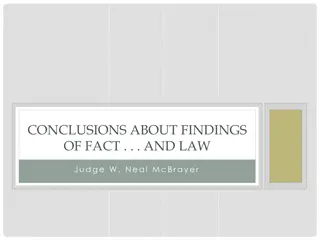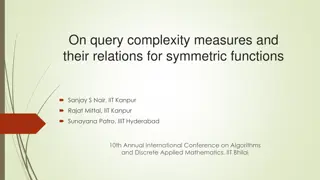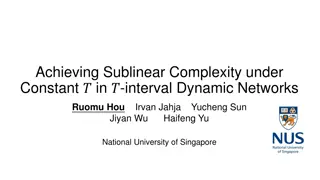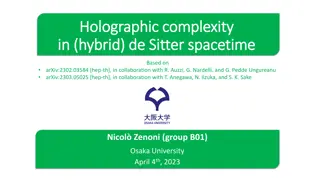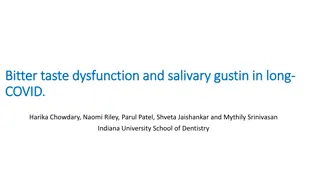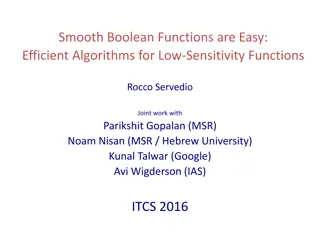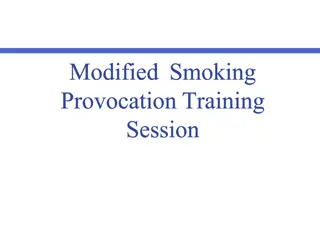COVID Complexity & Calamitous Conclusions: A Provocation
Delve into the intricate dynamics of the COVID pandemic, exploring the shape of the crisis, the efficacy of social control policies, and the limits of suppression interventions. Uncover the complexities arising from disparate command systems, implementation heterogeneity, and temporal changes in public attitudes. Could the pandemic have unfolded differently without treatment and vaccination programs? Are calamitous conclusions inevitable in the face of such complexity?
Download Presentation

Please find below an Image/Link to download the presentation.
The content on the website is provided AS IS for your information and personal use only. It may not be sold, licensed, or shared on other websites without obtaining consent from the author.If you encounter any issues during the download, it is possible that the publisher has removed the file from their server.
You are allowed to download the files provided on this website for personal or commercial use, subject to the condition that they are used lawfully. All files are the property of their respective owners.
The content on the website is provided AS IS for your information and personal use only. It may not be sold, licensed, or shared on other websites without obtaining consent from the author.
E N D
Presentation Transcript
COVID, COMPLEXITY, COUNTERFACTUALS, & CALAMITOUS CONCLUSIONS: A PROVOCATION RAY PAWSON RAY PAWSON
COVID CURVES What was the shape of the pandemic? A, B or C? Why, in most countries, did social control policies (NPIs) met with fragile, oscillating success? A A B B The The counterfactual question- without treatment and vaccination programmes (PIs) would these social suppression strategies, in the long run, have struggled to success? C C
The limits of the social suppression interventions are exposed in complexity theory (eight modes identified in the next slides).
The dynamics of complexity (1) The dynamics of complexity (1) Disparate Command and Control Systems. The more autonomous the controlling network of hubs, the more likely that policy consistencies, contradictions, and conflicts will ensue. Interaction and emergence. In systems that comprise of multiple intervention effects are not additive but interactive. The combination of measures may reduce, compete with, or displace the intended effect. Policy discord and moral disharmony. Individuals who do not follow controls (free riders) still benefit from their imposition. The wayward actions of notable individuals may cause a tipping point creating a broader moral struggle between rule followers and rule breakers. Contextual heterogeneity. The ability to avoid infection and follow controls differs widely across communities. Measures designed to reduce infection, by ignoring such contextual heterogeneity, may have the perverse effect of intensifying health inequalities.
The dynamics of complexity (2) Implementation heterogeneity. Complex interventions have long implementation chains. Responsible agents often have different ambitions for the policies and different resources to execute them. Implementation heterogeneities generate outcome inconsistency. Ambiguity in regulations and guidelines. In complex, ever-changing interventions like COVID-19, some ambiguity in these regulations is inevitable, with unclear pronouncements introducing further diversity in the public response. Temporal change in public attitudes. Public allegiance and adherence to complex interventions varies over time. There is a typical rhythm to public commitment moving from enthusiasm, to acceptance, to routinisation, to fatigue. The pace of change in such motivational patterns is not predictable and not under the control of policy makers. Exit and sustainability effects. The easing of restrictions is itself a significant policy manoeuvre and carries all of the uncertainties and complexities associated with their introduction. The timing and execution of exit strategies is thus unpredictable and may generate rebound effects .
A Calamitous Conclusion? It was forever asserted that UK policy was led by the science No public policy has ever been subject to more effort, more management, more investment and more scrutiny than the social interventions to overcome the COVID pandemic. And yet the assembled NPIs provided only a halting, intermittent solution. Was this inevitable? With COVID have we witnessed the limits of policy evaluation?
Complexity Complexity dynamics and the dynamics and the oscillating impact oscillating impact of major policy of major policy interventions. interventions. Have we seen the Have we seen the merry merry- -go go- -round before? before? The time limited impact The time limited impact of crime deterrents and of crime deterrents and subsequent crime subsequent crime waves waves The trendless The trendless fluctuation of social fluctuation of social mobility mobility The boom and bust of The boom and bust of economic policy economic policy round The weak sustainability The weak sustainability of development / aid of development / aid programmes programmes The insoluble issue of The insoluble issue of demand management demand management for health services for health services ETC. ETC.
For Policymakers: Remember you are designing complex, adaptive, self- transformative systems. The key task is to try to anticipate the complexity dynamics. For Evaluators: Remember you are researching complex, adaptive, self- transformative systems. The key task is to try to trace the complexity dynamics
Background Reading Pawson R. The coronavirus response: Boxed in by models. Evaluation. 2021;27(2):149- 167. doi:10.1177/1356389020968579 Pawson R.(2021)The Denial of Complexity in Developing the UK COVID-19 Response. https://www.ramesesproject.org/media/WP3_-_Denial_of_complexity.pdf Pawson R. Do Lockdowns Work? Evidence from the UK. https://realism.leeds.ac.uk/wp- content/uploads/sites/56/2021/08/Do-Lockdowns-Work-Pawson2021.pdf Pilar Serrano-Gallardo, Ray Pawson and Ana Manzano (2021) Non-pharmaceutical interventions in COVID-19. A complexity analysis (Intervenciones no farmace ticas en la COVID-19. Un an lisis desde la complejidad) Gaceta Sanitaria (under review)




